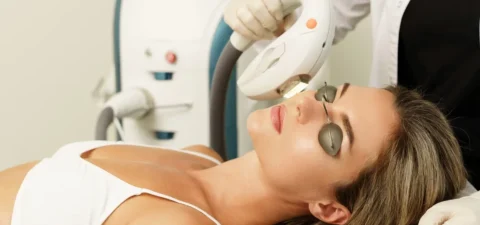For information only. Not meant as advice in any form. Please consult your medical professional or lawyer.
With more demand in the skincare and beauty industry, more career options are also opening up for people who want to make others look and feel their best. Being a licensed esthetician means providing people with facials and skin treatments that promote health and beauty. If you’re also interested in these things, then being an esthetician might be a fulfilling career for you.
So what’s the process to become a licensed esthetician? Just like any other career path, aspiring estheticians must make sure that they want to work in the beauty industry. After that, they have to enroll in an esthetics program, apply for a state license, pursue certification in a cosmetology school, and gain more field experience as estheticians.
Becoming an Esthetician: What You Need to Know
According to the Associated Skin Care Professionals (ASCP), there are around 183,000 licensed estheticians in the country. It’s a promising career because more people are getting invested in spending more money just to keep their skin young and healthy.
If you’re also interested in a career as a master esthetician, then here are some of the most important things to know:
What They Do
Estheticians work in the cosmetology field to evaluate beauty problems and recommend the best skin treatment for each client they have. They usually specialize in performing cosmetic skin treatments and recommending skincare products for wrinkles, hyperpigmentation, acne scars, blemishes, and other skin imperfections.
As a skincare specialist, a licensed esthetician mainly works in salons or spas to educate clients about their skin conditions. But some of them may also work in hospitals or nursing facilities as medical estheticians. Although both careers need an esthetician license, a medical esthetician is still different from other licensed estheticians because they perform more complex duties.
Here’s a list of what a basic esthetician and medical esthetician may perform:
| Licensed estheticians perform tasks like | Medical estheticians can also perform advanced esthetics tasks like |
| Skin analysisChemical peelsLaser treatmentsWaxing treatmentsFacialsMassage therapy for the head and neckBody wrapsMakeup applicationMicrodermabrasion | Permanent makeup proceduresDermal filler and Botox cosmetic injectionsAdvanced hair removalAssist another skin care specialist with pre and post-surgical skincare treatments |
How Much the Salary is
The average national salary for estheticians is $38,324 a year, but this greatly varies depending on different factors like location, experience, and working environment. Licensed estheticians in New York have the highest average annual salary at $45,484 per year (or $21.87 per hour).
Medical estheticians who are employed in medical spas, offices, clinics, and hospitals also receive more pay than regular estheticians in day spas or beauty salons. This is because they perform fewer body treatments and specialized skin care treatments.
How the Job Growth Looks
Getting into the beauty industry today as an esthetician is a huge career opportunity because the growth in this field is higher than average. Every day, esthetics continuously changes and grows thanks to the new products and services that are developed all the time.
Estheticians have the option to become independent contractors or work in a spa or salon. They can also attend training programs to become medical estheticians in hospitals, clinics, and physician offices.
What Personal Skills Are Needed
Like any other profession, being an esthetician also requires some skills to be the best in their chosen field. An aspiring esthetician should have the following skills:
- Aptitude for sales
- Interest in skincare and beauty products, as well as consumer information
- Capability to interact with clients, assess their condition, and meet their needs
- Being comfortable working with clients closely
- Awareness about the benefits and disadvantages of certain skincare products and their ingredients
- Ability to clearly communicate with patients and explain to them in layman’s terms
- Compassion and sensitivity to patients and their health concerns or issues
Step-by-Step Guide to Become an Esthetician
Like other professions, becoming a licensed esthetician doesn’t just happen overnight. Aspiring estheticians must complete certain training hours and pass state exams before they receive their license. Here’s a step-by-step guide if you want to continue down this career path:
Step 1: Make Sure This Career is Right For You
Before enrolling in esthetician schools, you need to meet the legal requirements first. This varies per state, but most of them only require that applicants must be at least 16 years old with a high school diploma or a GED certificate. But note that like with other jobs, some people are better suited to become an esthetician than others.
Estheticians closely work with clients, so they should be friendly and personable to make their patients feel relaxed and comfortable during each visit. They should also be organized, clean, and detail-oriented. Building a clientele base can be difficult at first, so aspiring estheticians should be highly motivated as they’re starting.
The schooling process can also be quite difficult, so they should have the right drive and motivation to continue. Being an esthetician might sound glamorous, but the entire process is a big commitment so it’s best to ask yourself if you’re up for the challenge while considering your personality, goals, availability, and commitment.
Step 2: Enroll in an Esthetician Program
After deciding that being an esthetician is the career path you want to take and meeting the requirements in the state, the next step is to find an esthetician school to enroll in. Cosmetology programs provide training in esthetician treatments and techniques, customer relations, and basic cosmetology.
When looking for an esthetician school that offers a good training program, make sure that it’s an accredited or approved cosmetology or esthetician program in the state. The National Accrediting Commission of Cosmetology Arts and Sciences (NACCAS) is one of the best accrediting agencies so check their list if your desired institution is included.
Things to Consider in an Esthetician School
- Provider’s reputation and review from previous students
- Well-balanced and well-crafted curriculum designed by accredited experts
- The institution’s staff and how they contribute to giving you quality continuing education
- Opportunities for practical application on real clients
- Advanced training classes and certification
What Topics to Expect in an Esthetician School
This varies per school depending on who designed the curriculum, but most esthetician schools teach about topics like:
- Physiology, anatomy, and nutrition
- Color psychology and aromatherapy
- Chemistry
- Esthetics equipment and electricity
- Facial treatments (cleansing, masking, and other therapies)
- Business management
- Hair removal
- Safety, sanitation, and first aid application
Step 3: Apply for a State License
The next step is to apply for and earn a license in the state you want to work in. Each state has corresponding requirements for licensure so make sure to research it to ensure that you’re applying for the correct license.
A state exam for aspiring estheticians typically involves a practical exam and written section to test the student’s theoretical knowledge, as well as their mastery of techniques in performing certain treatments. Most states also require renewing the esthetician license every certain number of years.
Step 4: Pursue Certification
Some companies don’t require certification when hiring estheticians, but having one emphasizes the applicant’s passion and dedication to the field. It might even make them stand out among other candidates who don’t have certification.
Licensed estheticians may start their certification process after attending cosmetology school and working for at least 2 years in the beauty industry. Once they complete all the requirements, estheticians can take the exam that gives them certification after they pass.
Some licensed estheticians choose to become standard estheticians, but others want to specialize in medical esthetics and work in a medical office. When enrolling in an esthetician school or program, make sure that it includes specific programs needed for the applicant’s chosen specialty.
Step 5: Gain More Field Experience
After obtaining a license and certification, the next step is to apply for entry-level positions to be exposed to the industry and gain real-life experiences. Licensed estheticians can choose between working in salons or spas that operate independently or in larger businesses like resorts, hotels, and hospitals.
Working in such environments allows estheticians to improve their skills and master their techniques. It’s also a good way to build a strong clientele base because some guests become familiar with your personality and work.
Once they have enough experience in working in the field, they may also gain the opportunity in other industries as makeup artists or PR representatives of beauty companies.
Explore Online Certification Courses at FACE Med Store Today
If being a licensed esthetician sounds like the perfect job for you, then it’s best to start the journey to reach your goals today. Learn from the best esthetician school in the area to have the training and experience needed to launch a career in the beauty industry.
Interested estheticians can also further their experience and knowledge about performing various treatments thanks to the online training courses at FACE Med Store. Call us today or visit our site to know more about our training programs.






